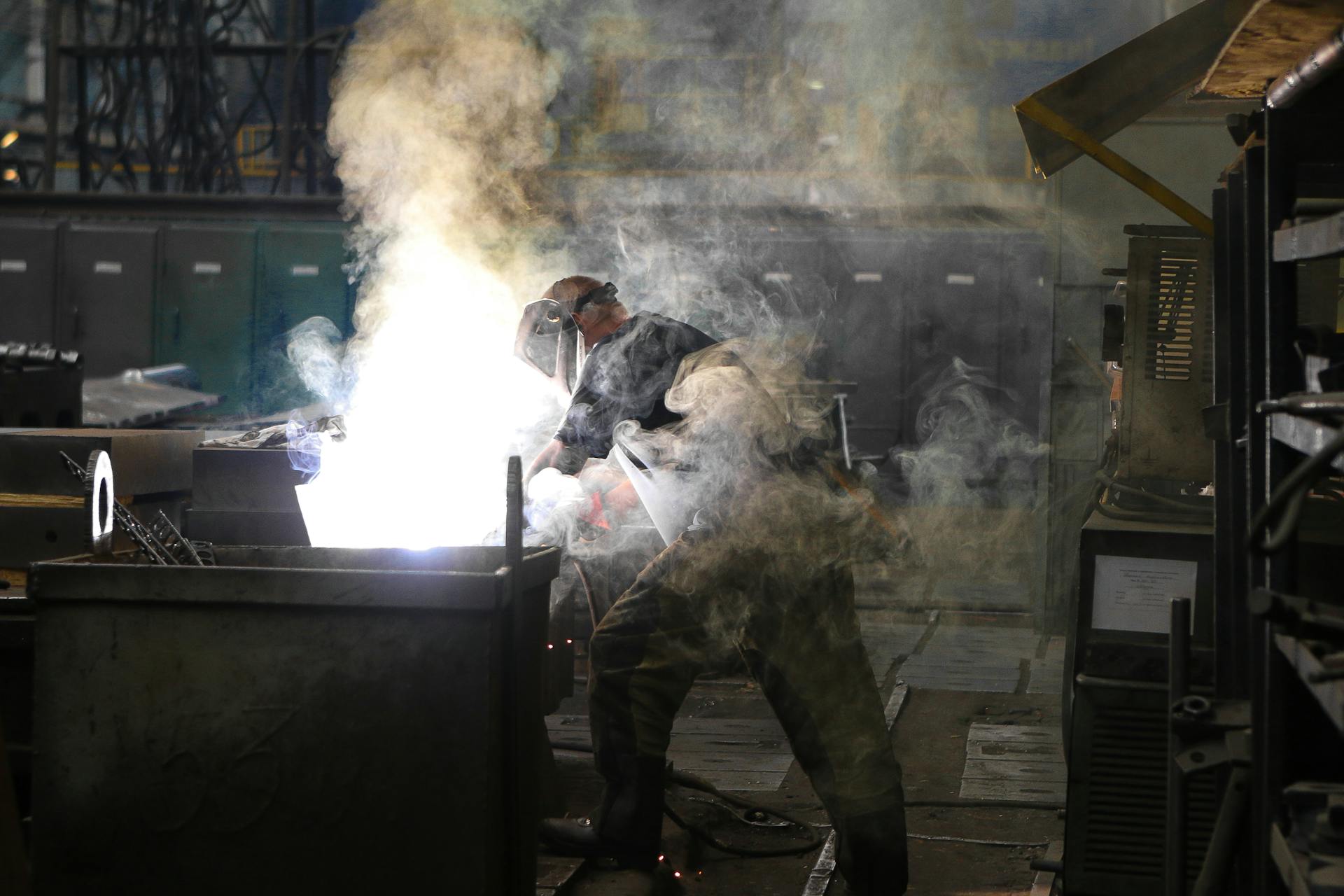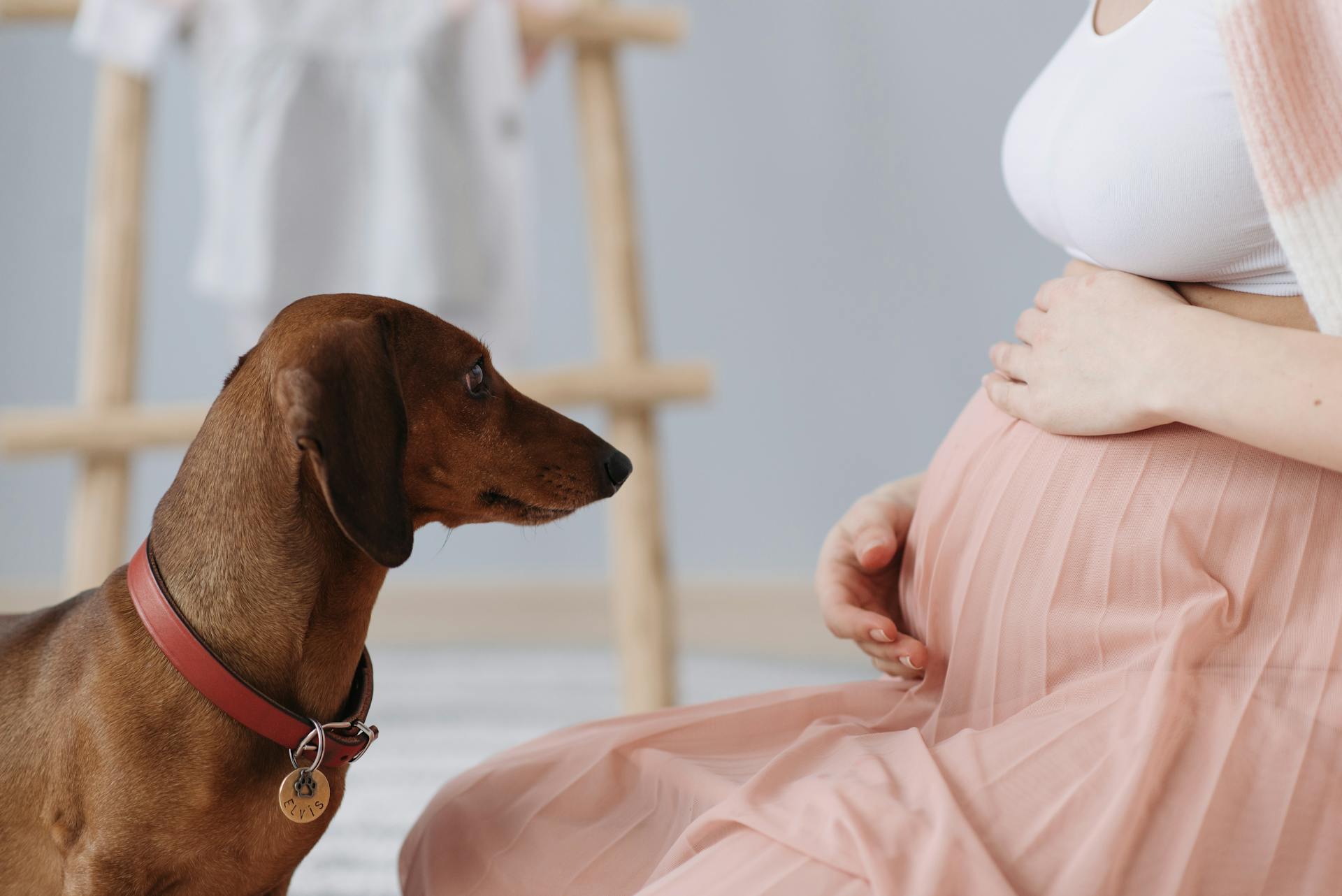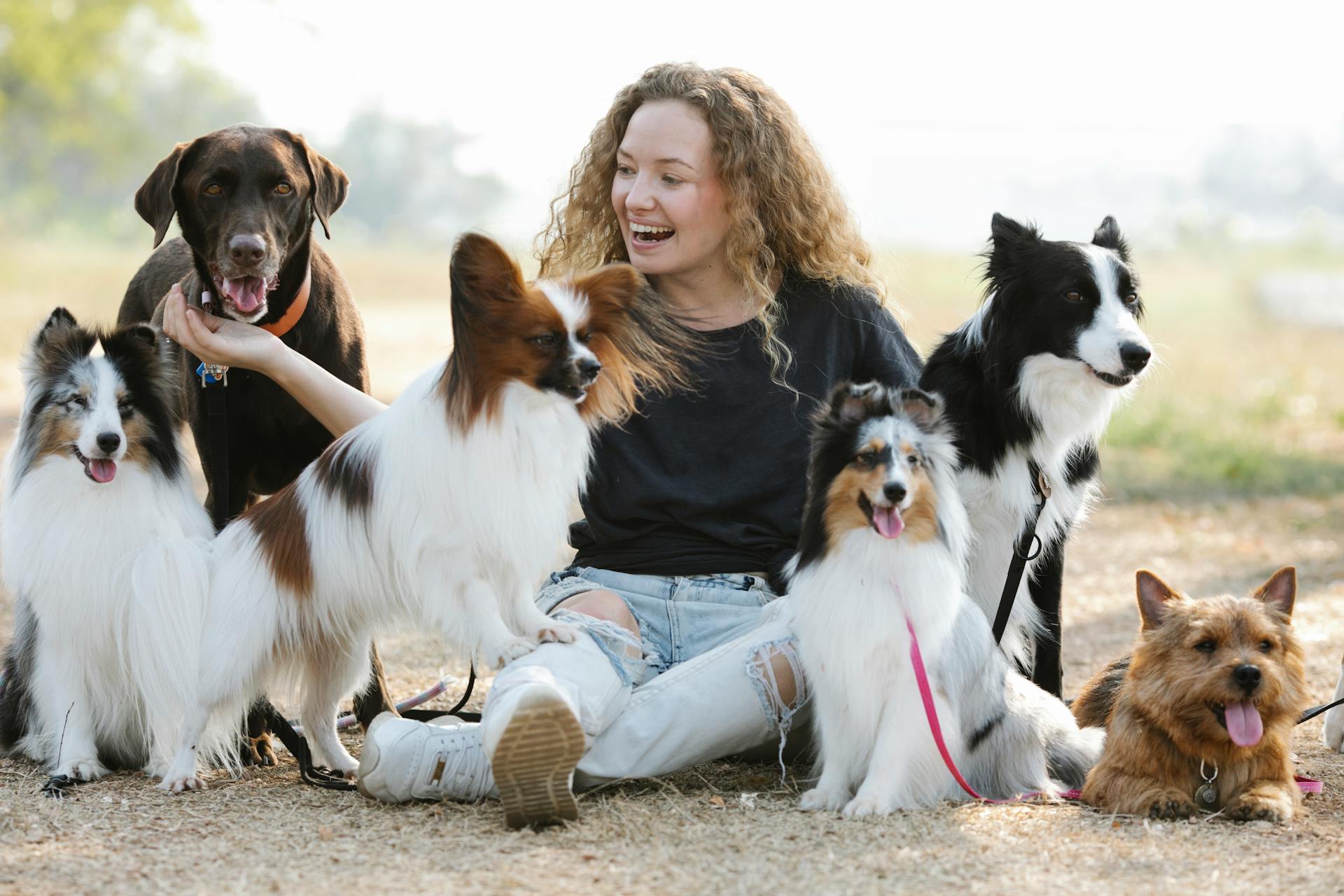
A female dog typically stays in heat for around 2-3 weeks, with some breeds experiencing longer cycles.
This duration can vary depending on factors such as age and breed, but most dogs will enter their first heat cycle between 6 to 12 months of age.
The exact timing of a female dog's heat cycle is influenced by her reproductive hormones, which regulate the release of eggs from the ovaries and prepare the uterus for potential pregnancy.
Curious to learn more? Check out: Female Dog Estrous Cycle
Understanding the Female Dog Heat Cycle
Female dogs typically mature and start their first heat cycle when they are six months old.
However, this can vary from dog to dog depending on breed size - miniature breeds may mature faster at four months, while giant breeds like Great Danes might not go into heat until two years old.
A typical female dog heat cycle lasts 2-3 weeks and is the time when a dog can get pregnant. Bitches are fertile during this period, but sperm can live in their birth canal for days, so it's best to keep them away from male dogs for the whole cycle if you don't want puppies.
For your interest: How Old Should a Female Dog Be to Breed
Here are the four phases of a female dog heat cycle:
- Proestrus: This is when bleeding occurs and the pup is getting ready for mating.
- Estrus: Ovulation happens, making it likely for the female dog to mate and become pregnant.
- Metestrus/Diestrus: The female dog is no longer fertile, lasting 60-90 days (2-3 months).
- Anestrus: She's no longer fertile, with vaginal discharge or a swollen vulva disappearing.
Unless you spay your dog or use medication to stop the heat cycle, it will happen every six months. However, this frequency can vary depending on breed size - small dogs may experience heat more often, up to every four months, while giant breeds are in heat less frequently, sometimes only once a year.
Calculating and Tracking the Cycle
Calculating and tracking your dog's heat cycle can be a bit tricky, but with the right tools and knowledge, you'll be able to stay on top of it.
To use our dog heat cycle calculator, you only need to enter the first day of the last female dog cycle. If you keep track of your dog's heat cycle and know her cycle's length, you can also enter it. The calculator will give you a predicted range of dates when the next heat cycle should happen.
You might enjoy: Female Dog Heat Cycle
Keep in mind that dogs' hormonal cycles vary a lot between breeds and also between individual dogs, so observing your dog and keeping close notes is the best way to predict a cycle. If your pup is young, her cycles might be irregular, making it harder to track.
Here's a quick rundown of what you need to know about tracking your dog's heat cycle:
- Keep track of the first day of each cycle;
- Record the length of each cycle;
- Use our calculator or observe your dog's behavior to predict when the next cycle will start.
Remember, it's always better to err on the side of caution and keep an eye out for any changes in your dog's behavior or discharge during her heat cycle.
Additional reading: Dog Names Female Start with S
Using the Calculator
To use our dog heat cycle calculator, you only need to enter the first day of the last female dog cycle.
If you keep track of your dog's heat cycle and know her cycle's length, you can also enter it. This is especially helpful if you want to predict when the next heat cycle should happen.
Expand your knowledge: Female Dog Heat Cycle Chart

The calculator will give you two important pieces of information: the predicted duration of this cycle, and a predicted range of dates when the next heat cycle should happen.
Keep in mind that dogs' hormonal cycles vary a lot between breeds and also between individual dogs. Observing your dog and keeping close notes is the best, most accurate way to predict a cycle.
If you're using the calculator for the first time, make sure to enter the correct information to get an accurate prediction. This will help you stay on top of your dog's heat cycles and plan accordingly.
Here are some tips to keep in mind when using the calculator:
- Make sure to enter the exact date of the last cycle.
- If you're unsure about the length of your dog's cycle, try entering different lengths to see how it affects the prediction.
- Keep a record of your dog's heat cycles and note any irregularities. This will help you fine-tune the calculator over time.
By following these tips and using our dog heat cycle calculator, you'll be able to stay ahead of your dog's heat cycles and plan for their future health and well-being.
Cycle Start Time
Most female dogs reach puberty between 6 to 24 months old, which is when their heat cycle begins.

The exact time of onset varies from one breed to another, depending on their size. Smaller breeds usually start their heat cycle earlier than larger breeds.
Some giant dog breeds may not go into heat until about 2 years old, while smaller breeds like Chihuahuas or Pomeranians can have their first cycle as early as four months old.
Female dogs typically mature and start their first heat cycle when they are six months old, but this can vary from dog to dog.
See what others are reading: Female Dog Names That Start with Sh
Definition of Silence
Silent heat can be a challenge for dog owners.
Some dogs may experience a silent cycle or silent heat, where they don't exhibit obvious signs of proestrus or estrus, such as vulvar swelling or vaginal discharge.
This means that even if your female dog isn't showing any visible symptoms, she could still be experiencing her heat cycle and become pregnant.
Silent cycles can occur frequently, so it's essential to stay attentive to the possibility.
Signs To Recognize
If your dog is in heat, you may notice some telltale signs that can help you identify this period.
Swelling of the vulva is one possible indicator, although it might not be immediately apparent to inexperienced dog owners.
Female dogs will often lick themselves more frequently during this time.
Vaginal discharge or bleeding is another common sign, which can range from a slight brownish color to a reddish hue.
Mood changes are also a possibility, with some dogs becoming clingy while others may need more space and become grumpy.
Appetite changes can occur as well, with some dogs refusing their usual dog food or becoming hungrier than usual.
Tail tucking at the beginning of the cycle is often followed by tail flagging when your dog reaches the estrus state.
Flirting with other dogs is a clear indication that she's in heat and ready to mate.
Here are the key signs to recognize:
- Bloody Discharge: Slightly brownish or reddish in color
- Tail tucking or tail flagging
- Reluctance to Eat or changes in appetite
- Restless and distracted indoors, often looking out the window or lying next to the door
- Mood Swings: Aggressive or agitated behavior due to hormonal imbalance
- Frequent urination with concentrated dog pheromones
These signs can help you identify when your dog is in heat and take steps to manage her behavior during this time.
Interacting with a Female in Heat

If a female dog is in heat, she'll likely be more affectionate and playful than usual, but also more prone to biting if she's not spayed.
She may also exhibit restlessness, pacing back and forth, and whining due to discomfort.
During this time, it's essential to keep her away from intact male dogs to prevent unwanted breeding.
A female dog in heat can be receptive to males for several days, typically 7-10 days on average.
It's crucial to supervise interactions between a female in heat and other dogs, as she may become overly aggressive or dominant.
Frequently Asked Questions and Expectations
Proestrus typically lasts around nine days, but can range from three to 17 days.
Dogs may become aggressive towards male dogs during this phase, but as it progresses, they'll stop being aggressive and start showing interest in them.
Male dogs will begin to show an interest in a female dog when she's in proestrus.
The discharge from her vulva will change color during the second phase of heat (estrus), becoming straw-colored with hints of brown or red.
Estrus can last anywhere from three to 18 days, averaging around nine days.
A pregnancy typically lasts about nine weeks, or approximately 63 days, after mating.
A fresh viewpoint: When Can a Female Dog Get Pregnant during Heat
What to Expect When You Are
When you're expecting a new addition to your family, there are certain changes you can expect to see in yourself. Your energy levels may decrease as your body prepares for the big day.

Your appetite may also change, and it's not uncommon to feel hungrier than usual or have a decreased interest in food altogether.
Some women become nervous and easily startled during this time, while others might feel more emotional and sensitive.
A common misconception is that morning sickness only occurs in the first trimester. While many women do experience it then, some may start feeling queasy as early as a week after conception or even later in their pregnancy.
Here are some possible physical symptoms you might encounter:
- Fatigue and exhaustion
- Mood swings and emotional changes
- Nausea and vomiting (morning sickness)
Keep in mind that these signs can also be indicative of other health issues unrelated to pregnancy. If you're concerned about any symptoms, it's always best to consult your healthcare provider for guidance.
Frequently Asked Questions
We've got a lot of questions about what to expect, and we're here to give you straight answers.
What is the typical duration of a project? Depending on its complexity, most projects take anywhere from 2-6 weeks to complete.

How often will I receive updates on my project's progress? You can expect weekly or bi-weekly check-ins with your assigned team member.
Can I make changes to my project after it has started? Yes, but keep in mind that any significant changes may incur additional costs and impact the project timeline.
What kind of support do you offer during the project? Our dedicated customer support team is available via email, phone, or live chat to help with any questions or concerns.
Frequently Asked Questions
How do you know when dog heat is over?
You know dog heat is over when all vulva swelling returns to normal size and bleeding or discharge stops. This usually indicates the end of the cycle.
How long do female dogs bleed while in heat?
Female dogs typically bleed for around 7-10 days during their heat cycle, with some dogs bleeding longer or shorter periods depending on size and individual factors. The duration of bleeding varies between dogs but usually accounts for about half of the total heat cycle.
What are the 4 stages of a dog's heat cycle?
A dog's heat cycle consists of four stages: proestrus, estrus, diestrus, and anestrus. These stages typically last between 14-21 days and are characterized by changes in vaginal discharge and reproductive behavior.
How many times do female dogs have periods a year?
Female dogs typically have 2 heats per year, lasting between 5-11 months, but some breeds may only cycle once yearly. The heat cycle is usually marked by a 14-21 day period of bloody vaginal discharge.
What age do dogs stop going into heat?
Dogs typically stop going into heat after a natural decline in reproductive hormones around 7-10 years of age. However, spaying or neutering can prevent heat cycles altogether, regardless of age.
Sources
- https://yourpetandyou.elanco.com/us/behavior/how-to-tell-if-your-dog-is-in-heat
- https://www.omnicalculator.com/biology/dog-heat-cycle
- https://www.goldenretrieverlife.com/blog/caring-for-your-dog-in-heat-frequently-asked-questions
- https://www.dogseechew.in/blog/dog-heat-cycle-timing-signs-tips-to-help
- https://www.whole-dog-journal.com/health/how-long-are-dogs-in-heat/
Featured Images: pexels.com


